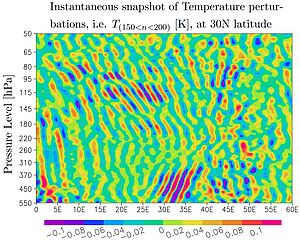Serhat Can (IAP) Macroturbulent Energy Cascades in Upper-Tropospheric/Lower-Stratospheric Mesoscales
Serhat Can (IAP) will deliver a talk in IAP colloquium on 14th June 2022 on the topic, "Macroturbulent Energy Cascades in Upper-Tropospheric/Lower-Stratospheric Mesoscales".
The talk will focus on how in recent years, a consensus has been reached regarding the direction of the energy cascade in the mesoscales in the Upper Tropospheric-Lower Stratospheric (UTLS) altitudes. Numerous measurements and model results confirm the existence of a predominantly forward spectral energy flux from low to high horizontal wavenumbers. However, the details to explain the observed -5/3 power law for Kinetic and Available Potential Energy (KE and APE) are still under heavy discussion. In this study, we performed simulations using the dry version of the Kühlungsborn Mechanistic general Circulation Model (KMCM) with high horizontal and vertical resolution for permanent January conditions to investigate the simulated KE and APE spectra with regard to the scaling laws of Stratified Macro-Turbulence (SMT). Horizontal diffusion schemes for horizontal momentum and sensible heat satisfy the Scale Invariance Criterion (SIC) using the Dynamic Smagorinsky Model (DSM). Zonally and temporally averaged SMT statistics as well as the horizontally averaged spectral tendencies and fluxes of KE & APE at the UTLS altitudes indicate that the dynamics behind the simulated -5/3 slope are highly nonlinear and governed according to SMT. Prevalence of mid-frequency Gravity Waves (GWs) at these altitudes in the model invoked the application of the saturated GW theory. Accordingly, it was found that the generation of SMT at UTLS region is a consequence of the saturated westward GWs (WGWs) around subtropical mid-latitudes, which are generated by the zonal mean flow. We finally show that the generation of SMT due to saturated WGWs is not captured in the model if both horizontal momentum and sensible heat diffusion parameterizations do not comply with SIC.













